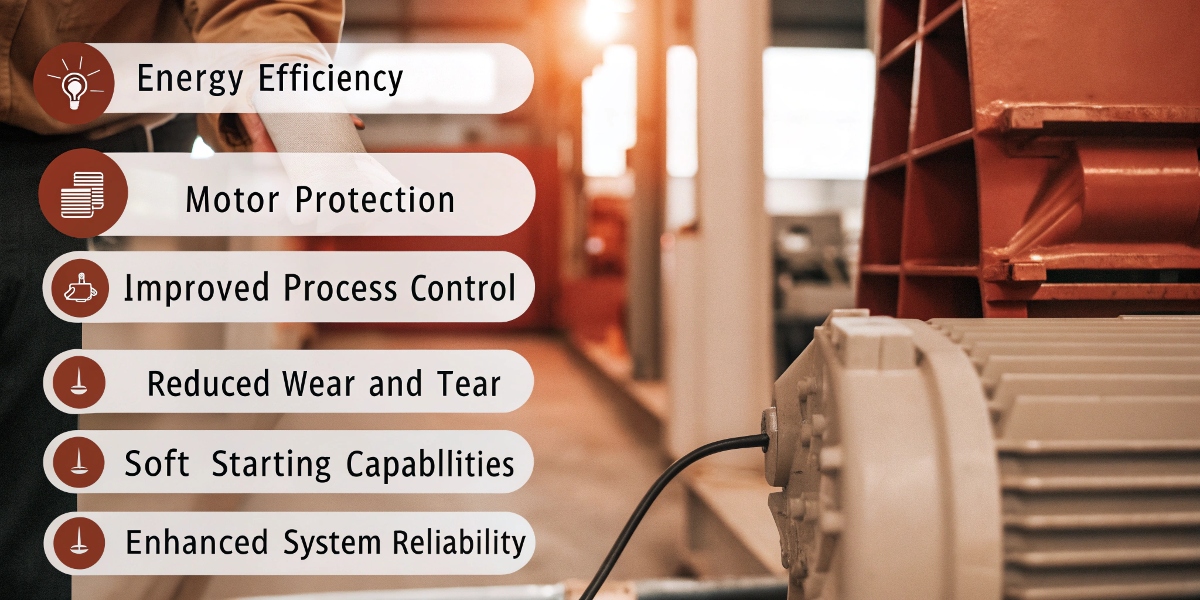The 6 Key Benefits of Using a Variable Frequency Drive (VFD) in Industrial Applications

In the fast-evolving world of industrial operations, efficiency, sustainability, and cost savings are critical drivers of success. Enter Variable Frequency Drives (VFDs), a transformative technology that optimizes electric motor performance by precisely controlling speed and torque through adjustments to power frequency and voltage. From manufacturing plants to commercial HVAC systems, VFDs are redefining how industries achieve operational excellence.
If you’re aiming to streamline processes, cut energy costs, or extend equipment longevity, VFDs are a powerful solution. In this article, we explore six transformative benefits of VFDs that make them indispensable for modern industries striving to stay competitive and sustainable.
1. Drastically Reduce Energy Costs
Energy efficiency is a top concern for businesses looking to lower operational expenses and meet environmental standards. VFDs shine by enabling motors to run at precisely the speed required for the task, avoiding the energy waste of constant full-speed operation. This is particularly impactful in applications like pumps, fans, and compressors, where demand varies throughout the day.
For instance, in a wastewater treatment plant, a VFD can reduce pump speed during off-peak hours, potentially slashing energy consumption by up to 50%. Industry data suggests VFDs can achieve energy savings of 20-60% in variable-load systems. These savings translate to lower utility bills and a reduced carbon footprint, aligning with global sustainability goals and regulatory requirements.
By optimizing energy use, VFDs deliver immediate financial benefits while supporting eco-conscious operations.
2. Precision Control for Optimal Performance
In industries where accuracy is non-negotiable—such as food production, pharmaceuticals, or automated manufacturing—VFDs provide granular control over motor speed. This allows operators to fine-tune processes to meet exact specifications, ensuring consistent quality and efficiency.
Imagine a packaging line where conveyor speeds must adjust to handle different product sizes. A VFD ensures seamless transitions, reducing errors and waste. Integrated with automation systems, VFDs can respond to real-time data from sensors, adapting instantly to changing conditions. This precision enhances product quality, minimizes downtime, and boosts overall productivity.
With VFDs, businesses gain the flexibility to maintain high standards across diverse operational demands.
3. Extend Equipment Longevity
Frequent starts and stops or constant high-speed operation can take a toll on motors and mechanical components. VFDs mitigate this by enabling soft starts and stops, gradually ramping up or down motor speed to minimize stress. This gentle operation significantly extends the lifespan of motors, bearings, and other system components.
For example, in an industrial HVAC system, abrupt starts can strain fan belts and bearings. A VFD eliminates this by smoothly accelerating the motor, reducing wear and tear. This is especially valuable in high-demand applications like mining or chemical processing, where equipment reliability is critical.
By protecting your assets, VFDs help avoid costly replacements and ensure long-term operational stability.
4. Minimize Maintenance Costs and Downtime
Unplanned maintenance and equipment failures can disrupt production and inflate costs. VFDs reduce these risks by easing mechanical and electrical stress on motors. Operating at optimal speeds and avoiding harsh startups lowers the likelihood of breakdowns, extending maintenance intervals.
Advanced VFDs often include diagnostic tools that monitor motor performance, detecting issues like overheating or abnormal vibrations before they escalate. For instance, in a factory setting, a VFD can alert maintenance teams to potential problems, enabling proactive repairs. This predictive approach reduces downtime and repair costs, keeping operations running smoothly.
With VFDs, businesses can allocate resources more effectively, focusing on growth rather than repairs.
5. Maximize System Efficiency
VFDs are engineered to optimize motor-driven systems, particularly in applications with fluctuating loads. By matching motor speed to actual demand, VFDs eliminate the energy losses associated with overpowered operation. This is especially effective in systems governed by affinity laws, such as centrifugal pumps or fans, where a small speed reduction yields significant energy savings.
For example, reducing a fan’s speed by 20% can cut power consumption by nearly 50%. Beyond energy, VFDs reduce heat buildup and electrical noise, easing the load on your electrical infrastructure. This holistic efficiency improves system performance and lowers operational costs across the board.
VFDs are a cornerstone of lean, high-performing industrial systems.
6. Unmatched Flexibility for Dynamic Operations
In today’s fast-paced industrial landscape, adaptability is key. VFDs offer unparalleled flexibility, allowing businesses to adjust motor performance to meet evolving needs, whether it’s scaling production, adapting to seasonal changes, or integrating new technologies.
In a commercial building, for instance, a VFD can adjust HVAC fan speeds based on occupancy or weather conditions, ensuring comfort while minimizing energy use. In manufacturing, VFDs can be reprogrammed to support new processes without requiring costly equipment upgrades. This adaptability ensures VFDs remain relevant as your business grows or pivots.
With VFDs, you’re equipped to handle whatever challenges the future brings.
Why VFDs Are Essential for Your Business
Variable Frequency Drives are more than just a motor control solution—they’re a strategic tool for achieving efficiency, reliability, and sustainability. By delivering energy savings, precision control, extended equipment life, lower maintenance costs, system efficiency, and operational flexibility, VFDs empower businesses to thrive in a competitive market.
Whether you’re managing a small facility or a large industrial operation, VFDs can transform your processes, reduce costs, and support environmental goals. Ready to unlock these benefits? Contact a trusted VFD supplier or automation expert to find the perfect solution for your needs.
Invest in VFDs today and propel your operations toward a more efficient, sustainable, and profitable future.

